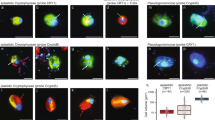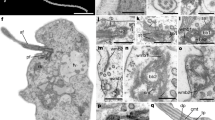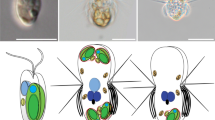Abstract
Mesodinium rubrum (Lohmann 1908) Jankowski 1976 (= Myrionecta rubra)1,2 is a common photosynthetic marine planktonic ciliate which can form coastal red-tides3. It may represent a ‘species complex’4,5 and since Darwin's voyage on the Beagle, it has been of great cytological, physiological and evolutionary interest4. It is considered to be functionally a phytoplankter because it was thought to have lost the capacity to feed and possesses a highly modified algal endosymbiont5,6. Whether M. rubrum is the result of a permanent endosymbiosis or a transient association between a ciliate and an alga is controversial7. We conducted ‘feeding’ experiments to determine how exposure to a cryptophyte alga affects M. rubrum. Here we show that although M. rubrum lacks a cytostome (oral cavity)8, it ingests cryptophytes and steals their organelles, and may not maintain a permanent endosymbiont. M. rubrum does not fall into recognized cellular or functional categories, but may be a chimaera partially supported by organelle robbery.
This is a preview of subscription content, access via your institution
Access options
Subscribe to this journal
Receive 51 print issues and online access
$199.00 per year
only $3.90 per issue
Buy this article
- Purchase on Springer Link
- Instant access to full article PDF
Prices may be subject to local taxes which are calculated during checkout



Similar content being viewed by others
References
Small, E. B. & Lynn, D. H. in Illustrated Guide to the Protozog (eds Lee, J. J., Hunter, S. H. & Bovee, E. C.) 393– 575 (Allen Press, Kansas, 1985).
Krainer, K. -H. & Foissner, W. Revision of the genus Askenasia Blochmann, 1895, with proposal of two new species, and description of Rhabdoaskenasia minima N. G., N. Sp. (Ciliophora, Cyclotrichida). J. Protozool. 37, 414 –427 (1990).
Montagnes, D. J. S. & Lynn, D. H. The annual cycle of Mesodinium rubrum in the waters surrounding the Isles of Shoals, Gulf of Maine. J. Plank. Res. 11, 193– 201 (1989).
Lindholm, T. in Advances in Aquatic Microbiology. Vol. 3 (eds Jannasch, H. W. & Williams, P. J.) 1–48 (Academic, London 1985).
Crawford, D. W. Mesodinium rubrum: the phytoplankter that wasn't. Mar. Ecol. Prog. Ser. 58, 161–174 ( 1989).
Oakley, B. R. & Taylor, F. J. R. Evidence for a new type of endosymbiotic organization in a population of the ciliate Mesodinium rubrum from British Columbia. BioSystems 10, 361–369 (1978).
Hibberd, D. J. Observations on the ultrastructure of the cryptomonad endosymbiont of the red-water ciliate Mesodinium rubrum. J. Mar. Biol. Assoc. UK 57, 45–61 ( 1977).
Lindholm, T., Lindroos, P. & Mörk, A.-C. Ultrastructure of the photosynthetic ciliate Mesodinium rubrum. BioSystems 21, 141 –149 (1988).
Taylor, F. J. R., Blackbourn, D. J. & Blackbourn, J. The red-water ciliate Mesodinium rubrum and its “incomplete symbionts”: a review including new ultrastructural observations. J. Fish. Res. Bd Can. 28, 391–407 (1971).
Barber, R. T., White, A. W. & Siegelman, H. W. Evidence for a cryptomonad symbiont in the ciliate, Cyclotrichium meunieri. J. Phycol. 5, 86–88 (1969).
Laval-Peuto, M., Salvano, P., Gayol, P. & Gruet, C. Mixotrophy in marine planktonic ciliates: ultrastructure study of Tontonia appendiculariformis (Ciliophora, Oligotrichina). Mar. Microb. Food Webs 1, 81–104 (1986).
Stoecker, D. K. & Silver, M. W. Replacement and aging of chloroplasts in Strombidium capitatum (Ciliophora:Oligotrichida). Mar. Biol. 107, 491–502 (1990).
Lindholm, T. & Mörk, A.-C. Symbiotic algae and plastids in planktonic ciliates. Mem. Soc. Fauna Flora Fennica 65, 17–22 (1989).
Hargraves, P. Narrow River phytoplankton. Maritimes 35, 6–8 (1991).
Packard, T. T., Blasco, D. & Barber, R. T. in Upwelling Ecosystems (eds Boje, R. & Tomczak, M.) 73–89 (Springer, New York, 1978).
Crawford, D. W., Purdie, D. A., Lockwood, A. P. M. & Weissman, P. Recurrent red-tides in the Southampton Water estuary caused by the phototrophic ciliate Mesodinium rubrum. Est. Coast. Shelf Sci. 45, 799–812 (1997).
Smith, W. O. & Barber, R. T. A carbon budget for the autrophic ciliate Mesodinium rubrum. J. Phycol. 15, 27–33 (1979).
Wilkerson, F. P. & Grunseich, G. Formation of blooms by the symbiotic ciliate Mesodinium rubrum: the significance of nitrogen uptake. J. Plank. Res. 12, 973 –989 (1990).
Kifle, D. & Purdie, D. A. The seasonal abundance of the phototrophic ciliate Mesodinium rubrum in Southampton Water, England. J. Plank. Res. 15, 823– 833 (1993).
Stoecker, D. K., Taniguchi, A. & Michaels, A. E. Abundance of autotrophic, mixotrophic and heterotrophic planktonic ciliates in shelf and slope waters. Mar. Ecol. Prog. Ser. 50, 241–254 ( 1989).
Stoecker, D. K., Putt, M., Davis, L. H. & Michaels, A. E. Photosynthesis in Mesodinium rubrum: species-specific measurements and comparison to community rates. Mar. Ecol. Prog. Ser. 73, 245–252 (1991).
Sanders, R. W. Seasonal distributions of the photosynthesizing ciliates Laboea strobila and Myrionecta rubra (= Mesodinium rubrum) in an estuary of the Gulf of Maine. Aquatic Microb. Ecol. 9, 237–242 (1995).
Crawford, D. W. & Lindholm, T. Some observations on vertical distribution and migration of the phototrophic ciliate Mesodinium rubrum (= Myrionecta rubra) in a stratified brackish inlet. Aquatic Microb. Ecol. 13, 267–274 (1997).
Yih, W. & Shim, J. H. The planktonic phototrophic ciliate, Mesodinium rubrum, as a useful organism for marine biotechnological applications. J. Mar. Biotechnol. 5, 82– 85 (1997).
Stoecker, D. K. in Protozoa and Their Role in Marine Processes Vol. G 25 (eds Reid, P. C. et al.) 161–179 (NATO ASI Series, Springer, Berlin–Heidelberg, 1991).
Stoecker, D. K., Michaels, A. E. & Davis, L. H. Large proportion of marine planktonic ciliates found to contain functional chloroplasts. Nature 326, 790–792 (1987).
White, A. W., Sheath, R. G. & Hellebust, J. A. A red tide caused by the marine ciliate Mesodinium rubrum in Passamaquoddy Bay, including pigment and ultrastructure studies of the endosymbiont. J. Fish. Res. Bd Can. 34, 413–416 (1977).
Stoecker, D. K., Silver, M. W., Michaels, A. E. & Davis, L. H. Obligate mixotrophy in Laboea strobila, a ciliate which retains chloroplasts. Mar. Biol. 99, 415–423 (1988).
Acknowledgements
We thank P. Del Giorgio for discussions; D. W. Coats, P. Krugens and G. Sellers for taxonomic assistance; and A. Li for isolating the cryptophyte. This work was partially supported by the US NSF Polar and Biological Oceanography (D.K.S.) and Maryland Sea Grant (K.S.).
Author information
Authors and Affiliations
Corresponding author
Rights and permissions
About this article
Cite this article
Gustafson, D., Stoecker, D., Johnson, M. et al. Cryptophyte algae are robbed of their organelles by the marine ciliate Mesodinium rubrum. Nature 405, 1049–1052 (2000). https://doi.org/10.1038/35016570
Received:
Accepted:
Issue Date:
DOI: https://doi.org/10.1038/35016570
This article is cited by
-
Retrieval of Micro-Phytoplankton Density using Sentinel-3 and MODIS Satellite Sensors on the Eastern Algerian Coast
Thalassas: An International Journal of Marine Sciences (2024)
-
Spatial fragmentation in the distribution of diatom endosymbionts from the taxonomically clarified dinophyte Kryptoperidinium triquetrum (= Kryptoperidinium foliaceum, Peridiniales)
Scientific Reports (2023)
-
Limits to the cellular control of sequestered cryptophyte prey in the marine ciliate Mesodinium rubrum
The ISME Journal (2021)
-
Harmful algal blooms and environmentally friendly control strategies in Japan
Fisheries Science (2021)
-
Functional kleptoplasts intermediate incorporation of carbon and nitrogen in cells of the Sacoglossa sea slug Elysia viridis
Scientific Reports (2020)
Comments
By submitting a comment you agree to abide by our Terms and Community Guidelines. If you find something abusive or that does not comply with our terms or guidelines please flag it as inappropriate.



